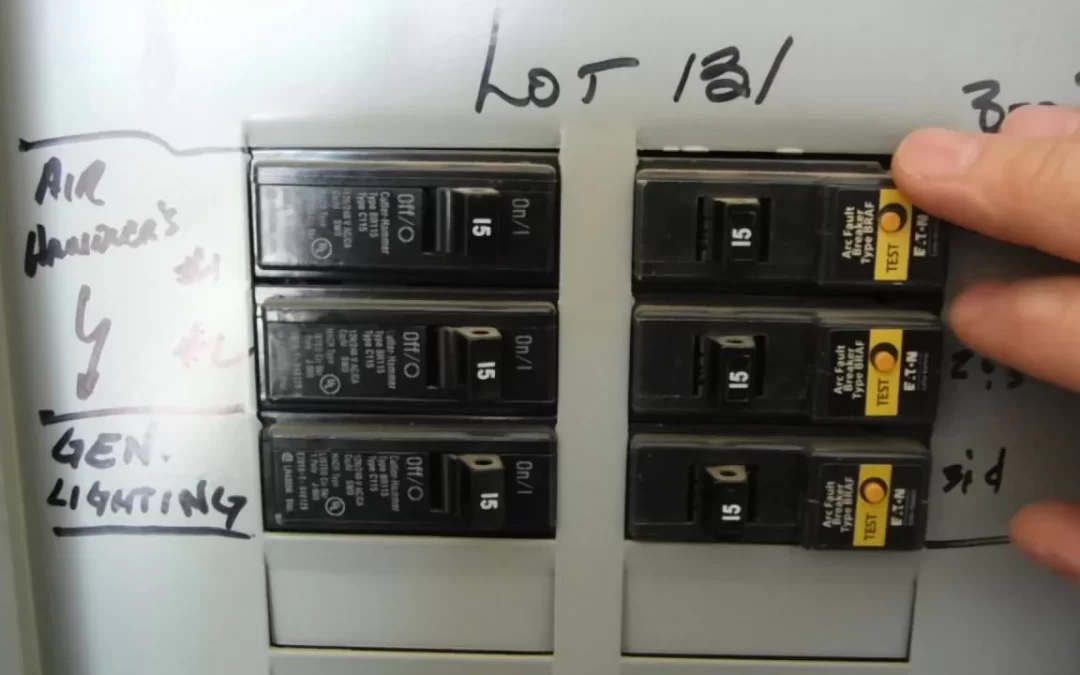Arc Fault Circuit Interrupters (AFCIs) are required by the National Electrical Code for certain electrical circuits in the home. Most people are familiar with the term arcing. Arcing may be intended, such as with an arc welder or unintended, such as when a tree falls on a power line during a storm creating a current discharge between conductors or to the ground.
An arc fault is an unintended arc created by current flowing through an unplanned path. Arcing creates high intensity heating at the point of the arc resulting in burning particles that may easily ignite surrounding material, such as wood framing or insulation. The temperatures of these arcs can exceed 10,000 degrees Fahrenheit.
Use in Home or Office
Smoke alarms, fire extinguishers and escape ladders are all examples of emergency equipment used in homes to act when a fire occurs. An AFCI is a product that is designed to detect a wide range of arcing electrical faults to help reduce the electrical system from being an ignition source of a fire. Conventional overcurrent protective devices do not detect low level hazardous arcing currents that have the potential to initiate electrical fires. It is well known that electrical fires do exist and take many lives and damage or destroy significant amounts of property. Electrical fires can be a silent killer occurring in areas of the home that are hidden from view and early detection. The objective is to protect the circuit in a manner that will reduce its chances of being a source of an electrical fire.
Monitoring
Unlike a standard circuit breaker detecting overloads and short circuits, an AFCI utilizes advanced electronic technology to “sense” the different arcing conditions. While there are different technologies employed to measure arcs by the various AFCI manufacturers, the end result is the same, detecting parallel arcs (line to line, line to neutral and line to ground) and/or series arcs (arcing in series with one of the conductors).
How does arc fault detection work? In essence, the detection is accomplished by the use of advanced electronic technology to monitor the circuit for the presence of “normal” and “dangerous” arcing conditions. Some equipment in the home, such as a motor driven vacuum cleaner or furnace motor, naturally creates arcs. This is considered to be a normal arcing condition. Another normal arcing condition that can sometimes be seen is when a light switch is turned off and the opening of the contacts creates an arc.
A dangerous arc, as mentioned earlier, occurs for many reasons including damage of the electrical conductor insulation. When arcing occurs, the AFCI analyzes the characteristics of the event and determines if it is a hazardous event. AFCI manufacturers test for the hundreds of possible operating conditions and then program their devices to monitor constantly for the normal and dangerous arcing conditions.
Types
AFCIs are intended to mitigate the effects of arcing faults by functioning to de-energize the circuit when an arc fault is detected. AFCIs are required by the NEC® to be a listed product. This means that they must be evaluated by a nationally recognized testing laboratory to the national standard for AFCIs (UL 1699). NEC 210.12 establishes the requirement to use AFCIs. Protection is required for branch circuits in locations as specified in this NEC® rule.
- Branch/Feeder Breaker AFCI A device intended to be installed at the origin of a branch circuit or feeder, such as at a panelboard. The branch/feeder AFCI provides for detection of arcing faults that can occur line-to-line, line-to-neutral and line-to-ground. To be able to handle shared neutral circuits (a common application in older homes), a two-pole AFCI can be used. This will accommodate the three-wire circuit arrangement used in shared neutral applications.
- Combination Breaker AFCI In addition to the protection provided by the Branch Feeder AFCI, the Combination AFCI provides for series arc detection down to 5 amperes. This series of arc detection is beneficial to detect lower level arcing in both branch circuits and power supply cords. Combination AFCI protection is required by the NEC® as of January 1, 2020.
- Breaker AFCI and GFCI Protection An AFCI can be used in conjunction with GFCI protection to provide both arcing fault protection as well as 5mA ground fault (people) protection. A common way to provide both types of protection is to use an AFCI circuit breaker and a GFCI receptacle. AFCIs can also incorporate 5mA GFCI protection into the same package. This solution for AFCI breaker and GFCI on the same circuit can be useful where the circuit design requires both types of protection or where the installer (or user) wants to have both types of protection.
Installation
The basic difference between installing the breaker AFCI versus a standard thermal magnetic circuit breaker is the requirement to connect both the hot and neutral conductor to the proper terminals of the breaker AFCI. In a circuit wired with a conventional circuit breaker, the hot conductor is connected to the breaker and the neutral conductor is connected directly to the neutral bar of the load center.
Contact us
Hiring a professional electrician is the safest way to install AFCI breakers. Mikulka Electricians are always professional and efficient. Insured and trained to do the job right the first time. Experts in the field of electrics with over 25 years’ experience. Prepared with up-front pricing and a lifetime guarantee. We observe all personal protective equipment and COVID 19 requirements to keep our staff and your family safe. Our team of experts will respond immediately to your call for help. Call Mikulka Electric, Inc. for a wide range of electrical services, including indoor and outdoor lighting, electrical heating, electrical repairs, and back-up generators. We service the Central New Jersey area. Address 275 RT. 79 Morganville, NJ 07751 https://mikulka-electric.com/contact-us/
Phone 855-645-8552 or 855-MIKULKA

